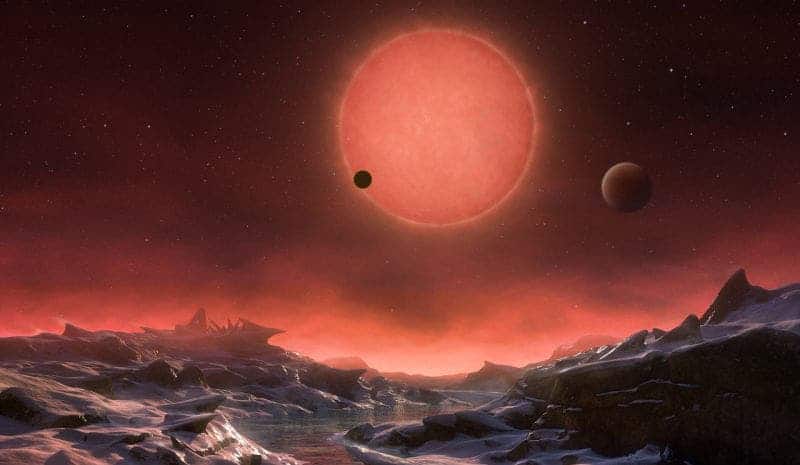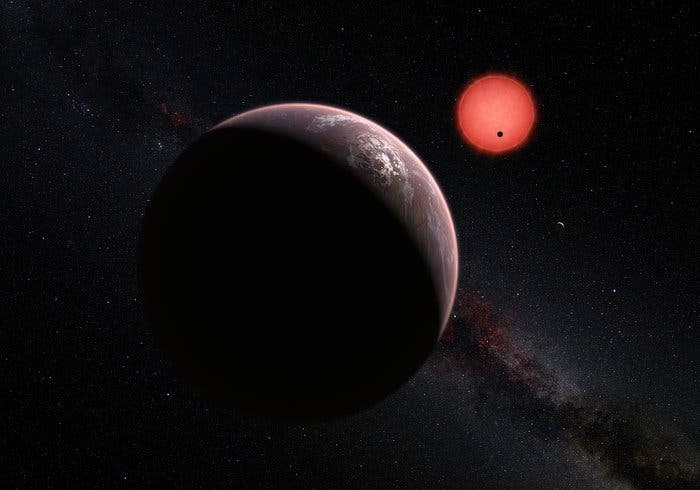Scientists have announced the discovery of three Earth-like planets orbiting a dim star. According to the study which describes them, the planets represent one of our best bets for finding life outside of our solar system.

Artist’s impression of the view from the surface of a planet orbiting TRAPPIST-1. Image: ESO/M. Kornmesser
The planets orbit an ultracool dwarf star, but because they are so close to the star, astronomers actually believe they lie in the habitable zone and can support life.
“These kinds of tiny, cold stars may be the places we should first look for life elsewhere in the universe, because they may be the only places where we can detect life on distant Earth-sized planets with our current technology,” study lead author Michaël Gillon, an astronomer at the University of Liège in Belgium, told Space.com
The findings are extremely exciting, with a real potential of actually hosting life.
“The kind of planets we’ve found are very exciting from the perspective of searching for life in the universe beyond Earth,” study author Adam Burgasser, a professor of physics at the University of California San Diego, said in a news release.
The star is called TRAPPIST-1, an ultracool brown dwarf located 39.13 light-years away in the Aquarius constellation. It’s only a touch larger than Jupiter, emitting a tiny fraction of our Sun’s total luminosity. However, the three planets are all much closer than the Earth is to the sun. Two of the planets orbit the star at periods of 1.5 days and 2.4 days.
“With such short orbital periods, the planets are between 20 and 100 times closer to their star than the Earth to the Sun,” said co-author Michaël Gillon of the University of Liège in Belgium. “The structure of this planetary system is much more similar in scale to the system of Jupiter’s moons than to that of the Solar System.”
So not only do the planets resemble Earth in terms of the light and heat they receive and in size, but they are also likely rocky. To make things even more intriguing, the two inner planets may be tidally locked – which means that they have one face constantly turned to the Sun while the other one is in complete darkness (just like we always see only one side of the moon). We have very little idea how life might look like on such a planet, but this may be counterproductive for life because it restricts the free circulation of water and clouds – water might evaporate on the hotter side and become trapped on the colder one. However, tidal forces or geothermal activity could also play a role, enabling this circulation. Researchers hope to better understand the planetary dynamic in a relatively short time.
“Fortunately, we may be able to answer these questions in the near future, as the geometry of the system makes it likely that we will be able to detect the atmospheric gases of these planets in the next decade with the launch of the James Webb Space Telescope,” Burgasser said. “This facility will allow us to search for biogenic gases–oxygen or methane for example–that would firmly indicate the presence of life, or search for other gas species that would tell us about the planets’ compositions, geothermal activity and evolutionary history.”
The search for exoplanets usually focuses on hot, bright stars, which are easier to spot in the night sky. The existence of such systems has been theorized several times before but this is the first time one was actually observed.
“This is basically a paradigm shift,” study co-author Julien de Wit told Gizmodo. “If these planets have atmospheres, they really are the best places to look for life.”
However, there are also advantages to studying dimmer planets: their light doesn’t “swallow up” the signal of rocky planets.
“It is easier to study the atmospheres of exoplanets orbiting dim stars,” de Wit said, explaining that as a star gets smaller, a larger fraction of its light can pass through a planet’s atmosphere.
The big question that now remains is: do these planets have an atmosphere? That’s really anyone’s guess now, but hopefully, we’ll have an answer in the near future.
Journal Reference: Temperate Earth-sized planets transiting a nearby ultracool dwarf star. Nature (2016) doi:10.1038/nature17448










